Yu-Gi-Oh! Stardust Accelerator: World Championship 2009 (Nintendo DS) Review
By Shane Jury  08.08.2009
08.08.2009
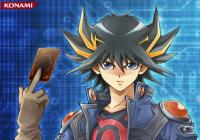
Since the advent of the manga stories way back in 1995, the Yu-Gi-Oh! franchise has gone from strength to strength, spawning an anime series, a real-life card game counterpart and, of course, the inevitable videogame adaptations. The majority of the Yu-Gi-Oh! games have been on Game Boy and DS, beginning with the Japan-only release Monster Capsule GB on Game Boy Colour, and the latest title, Stardust Accelerator, has just been released on the DS. Will adding the ridiculous idea of motorbikes to a card game be a rush of fresh air, or bring duels to a screeching halt?
Since 2005's Nightmare Troubadour all of the DS Yu-Gi-Oh! games have been built on one engine, with a 3D view of the field on the top screen, a 2D view on the bottom. This perspective worked well for navigation and usage of each card, but it certainly didn't do the grainy 3D monsters any favours, and over time the design has become increasingly stagnant. On top of that, each game's story mode has followed the same template of guiding a cursor on the touch screen to pick where you want to go or who to battle with, which did nothing for the games in the freshness stakes. At a time when it's most needed, when the anime and manga themselves go through the most drastic alteration in the series' history, Stardust Accelerator finally brings something completely new to the party - and only a fraction of it involves motorbikes.
On start up, you're prompted to name and design your character for use in the story mode. Your character wakes up in Satellite, the main hub of Stardust Accelerator's world. Inflicted with an unfortunate case of amnesia, a meeting with Rally (a supporting character from the 5D's anime) prompts you to realise that you are - surprise, surprise - a duelist, and the best way to regain your memory would be to play card games. From this point, the story follows the proceedings of the anime quite closely, as you meet up with Yusei Fudo's other friends, rescue them from bullies, get hauled into the Facility (Satellite's prison) and venture into New Domino City to take on the duelist king, Jack Atlus. The story does chug in places, and a few plotlines are left unresolved at the end, but it makes a nice change from endless dueling, and it is coupled with some great music that changes depending on duel progress.
Though it could have easily been depicted with the tried-and-tested method of dragging-cursor-to-go-to-point-A, Konami have instead rendered the game's world in a 3D isometric style. It gives off strong vibes of Cing's Another Code in conjunction with the puzzles, exploration and memory-regaining flashbacks - except the puzzles are insultingly easy, such as block-pushing rooms solvable by a toddler in every dungeon. Touch screen implementation matches Cing's effort; the whole game can be played easily without a single button press. There's also accurate calibration for card choosing, which is a godsend for the new dueling interface.
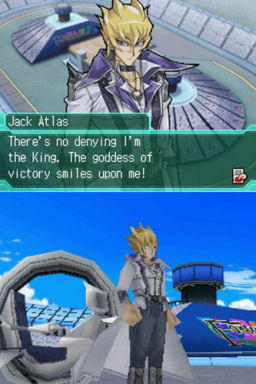
The dueling field is now on the bottom screen, also in isometric view. The once-grainy 3D monster models are now merely minimised accessory, and there's some excellent static art of them in one-on-one clashes instead. All that's left on the touch screen is a quick description of each card you highlight, your opponents' stats, and current duel conditions of life points and number of turns. Although at first it's difficult to focus on what you need through the jumble, this new layout works much better in the long run. Sometimes, though, when the action picks up as cards are activated left and right, in particular on the opponent's turn, frame rate problems appear and things can slow down quite a bit.
Stardust Accelerator's newest main feature is the addition of Turbo duels, which are regular duels played on motorbikes (named Duel Runners here). As cringeworthy as that sounds, it's surprising to realise that it is exactly the dose of freshness that Yu-Gi-Oh! has needed for years. It's a shame to see this mode of duel limited so harshly here, as it is only playable in story mode with select characters, there are only around 70 supporting cards for it, and it's not playable online at all.
Duel Monsters isn't the easiest game to learn to play, even by card game standards. Thankfully the effective tutorial mode returns, headed by some, ahem, personal coaching from Dark Magician Girl. Those that have mastered the basics of regular duels will find Turbo duels to feel like a natural progression for the game. In standard matches players mainly use monster, spell and trap cards, alongside fusion, ritual, effect and union monsters optionally, and the same mostly holds true for Turbo duels. The main changes for this mode involve speed counters that increase by one for each player's turn, and the newly-introduced Speed spells. These Turbo duel-only spells, which are either variations on already existing cards or completely new designs, can only be used in unison with speed counters, depending on card description and number of counters obtained. Although this sounds like a minor change, it completely adjusts your strategy to that unlike of a normal duel.
Another change for all duels is the addition of Synchro monsters. Unlike Fusion monsters, which require a Polymerization spell or another card with the same effect, Synchros can be summoned from the renamed Extra Deck (previously the Fusion Deck), at the cost of a Tuner monster along with other regular monsters on the field. All that you sacrifice must total the same star levels for the monster you want to summon. Again, like Speed spells, this addition gives a nice boost to the originality that the 5D's universe brings to the table, and again the low number of cards that support this new method hinders its effectiveness. It's no doubt something future editions will fix. Admittedly as an introduction to the concepts of Turbo and Synchro, a low number is for the best.

Outside of the story mode there's the World Championship, which neatly compiles all of the other features of the game and couples them with retro tunes from previous games in the series. Regular duels involve battling Duel Monster Duelists, each with decks consisting of themselves and cards that work best with their effects. Tag duels, once unlocked in story mode, allow you to team up with a partner and take on another tag team, sharing life points and field space. View mode lets you observe a choice of characters battling against each other; useful for getting to know their actions and strategies.
The Connect segment is your entryway to multiplayer, both local and online. Connecting to others rarely takes more than a minute, and there are plenty of parameters to set. You can pick duel type (single, tag or structured, where you choose a pre-set deck to play with; sadly no Turbo duels), region, friendly or ranked (for leaderboards), and whether limited/banned cards can be used or not. As well as online dueling, Konami are offering players free downloads of new cards, opponents, restrictions lists, and duel puzzles at least once a month, with news bulletins for big events. Dual puzzles present the player a situation that they have to escape and win in the same turn. To say these are challenging is an understatement; a nice addition for longevity.
Stardust Accelerator can easily be considered as the harshest (but fair) Yu-Gi-Oh! game yet. Given the quantity of cards available and the number of deck strategies created over the years, it'll come as no surprise to find that every opponent in the game is armed to the teeth with effective moves and cards, especially when comparing it with the average duelling deck you start off with. As such, Stardust is a fan's dream, but a newcomer's nightmare.
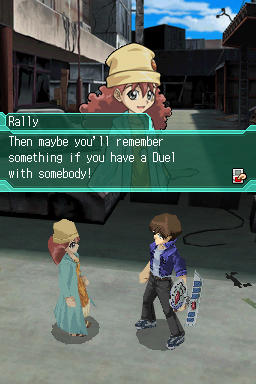
The game is significantly harder when it comes to tag duels. Putting it simply, the AI partner for these duels is completely brainless and useless. It uses your placed cards exactly when you don't want them to and it ignores the most obvious of moves. Not a problem for opponent AI, oh no, but when paired up with you they are a pain in the butt; you need to build a deck similar to theirs to get anywhere, which is a problem in itself. You only have one partner to start off with, and you have to beat a story mode character 10 times to partner with them.
Another area of Accelerator that adds unnecessary complication is the list of banned cards you have to adhere to. Some of the cards you receive in booster packs are banned from play for being too powerful, which raises the question of why these cards were included in the first place, and also why the computer players are allowed to. Even switching to another list you have downloaded doesn't help, as it's generally the same ones banned. Some sort of off-the-record mode allowing these cards to be used is needed and long overdue.
Stardust Accelerator is one of those games that, in the hands of the right player, will last them an incredibly long time. There are around 3,000 different cards to collect, dozens of opponents to challenge online and off, a lengthy story that pulls no punches in length or difficulty, and an in-depth deck creation mode. It's not a game to enthrall petrol-heads or card game haters, but Konami have laid the groundwork for future 5D editions, and given us an enjoyable title in the process.
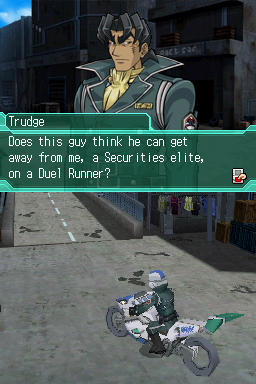
Cubed3 Rating
Great - Silver Award

Yusei Fudo's first headlining role in a videogame has turned out be the one the Yu-Gi-Oh! franchise needed to keep things from turning stale. Turbo dueling feels like a minor addition, but becomes a valuable part of the game that sadly isn't focused on enough. There's plenty here for series veterans to enjoy, but the merciless complexity of the AI will intimidate newcomers.
Comments
Comments are currently disabled

 Sign In
Sign In Game Details
Game Details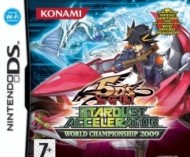
 Out now
Out now  Out now
Out now  Out now
Out now  TBA
TBA  Subscribe to this topic
Subscribe to this topic Features
Features





 Top
Top

